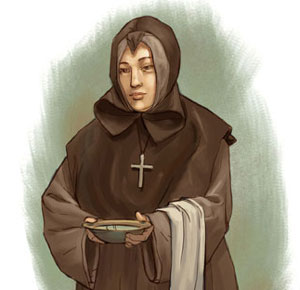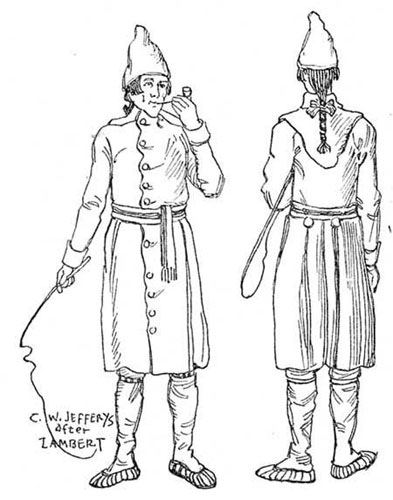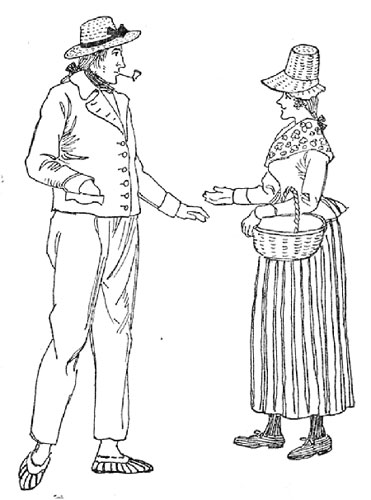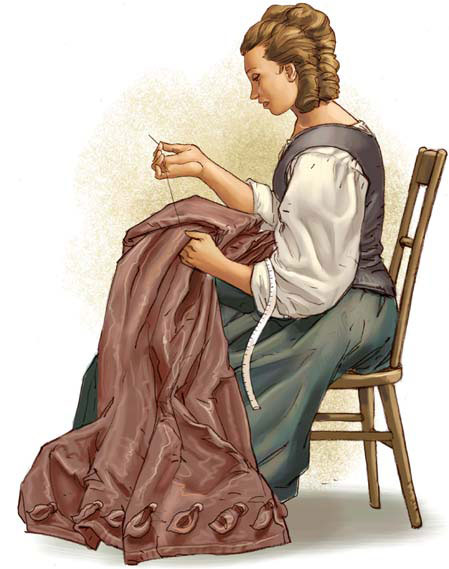1820s: Choose your character – all on one page

Note: This student site was imported from LEARN and now all the characters are available here on this one page! (Sorry, but you have to scroll way way down!)
Note also, there is a Cartograf scenario based on this collection at http://cartograf.learnquebec.ca/PublicMontreal1820 where you can see locations like these on the map, add your own, etc.
Louis-Joseph Papineau |
|
| Portrait of your character
Draw a comic strip to present your historical character. Use the texts, images and links below to inspire you. You can create your comic strip using drawing tools in your word processing or drawing software.
|
|
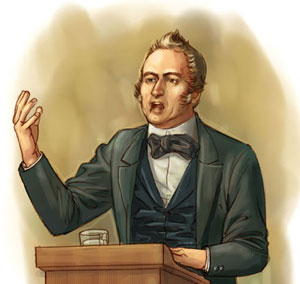 |
Dear readers,
My name is Louis-Joseph Papineau. I was born in Montréal in 1786. I’m writing this letter to inform future generations of what I accomplished during my lifetime. I was lucky enough to be born in a well-off family. My father, Joseph Papineau, was a politician. I married Julie Bruneau three years ago and we have two children. My family divides its time between our house in Montréal and our seigneury in the country. I followed in my father’s footsteps and became a politician too. Before that, I was a lawyer; however, I soon became bored with practicing law. To reach my full potential, I felt I needed to launch my political career. I was first elected member of parliament in 1808. Several years later, in 1815, I became the leader of the Parti Canadien.* |
| My work as a politician keeps me away from my family too much. I spend a lot of my time in Québec City, which is where the Legislative Assembly sits. The Assembly is made up of representatives elected by the population. We work hard to make decisions in the best interest of Canadians. Fighting for democracy is important to me. I believe that Lower Canada is a distinct geographical, economic and cultural space.
In my time, French-Canadians make up 90% of the population, but our leaders are British. Moreover, only landowners have the right to vote. I remember when Governor James Henry Craig has done something that particularly angered me. He closed down the newspaper Le Canadien because he didn’t agree with its views. This newspaper was the voice of the Parti Canadien. I am intending to go to London soon† to defend the interests of my people. The next few weeks are likely to be difficult. I miss my family. I’m working hard to give democracy the chance it deserves. *This party became the Parti Patriote in 1826. †In 1823, Papineau was sent to London with John Neilson to present a petition of 60,000 signatures opposing the Union project, which would have united the two provinces of Upper and Lower Canada. To find out more about the society of Lower Canada in the 1820s, visit our 1820s section |
|
The Merchant |
|
| Portrait of your character
Draw a comic strip to present your historical character. Use the texts, images, and links below to inspire you. You can create your comic strip using drawing tools in your word processing or drawing software. • Working document to help you create your comic strip: Download
|
|
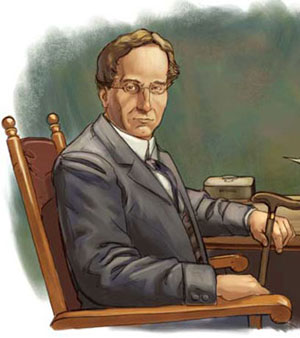 |
Hello,
My name is Augustin Cuvillier and I’m a merchant. My English-speaking colleagues call me Austin. I was born in Québec City in 1779. My father was a storekeeper. His life was very different from mine as he lived and worked in French for most of it. Since the British conquest in 1760, things have changed. English is now the language of business. After my studies at Collège Saint-Raphaël in Montréal, I worked for Henry Symes, a wealthy auctioneer. I took over his business in 1802. That same year, on November 7, I married Marie-Claire Perrault. My personal and political life is conducted in French, but my commercial activities are conducted in English. |
| I started my own business called “Cuvillier, Aylwin, and Harkness” in Montréal. As you can see from the name of my company, English merchants now dominate commercial activities in the former French colony.I’m also very interested in politics. After the Constitutional Act of 1791 divided the Canadian territory into Upper and Lower Canada, both were permitted to have elected representatives. I later won the seat for Huntingdon County in the Lower Canada Legislative Assembly in 1814.
To find out more about the society of Lower Canada in the 1820s, click visit our 1820s section |
|
| Cuvillier residence (ca. 1900) |
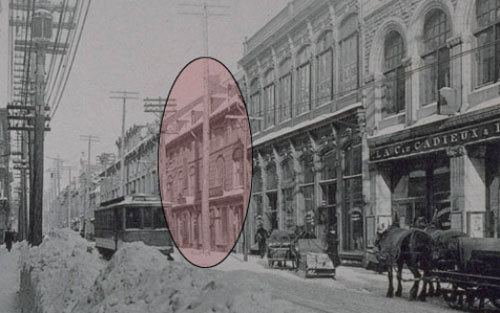 |
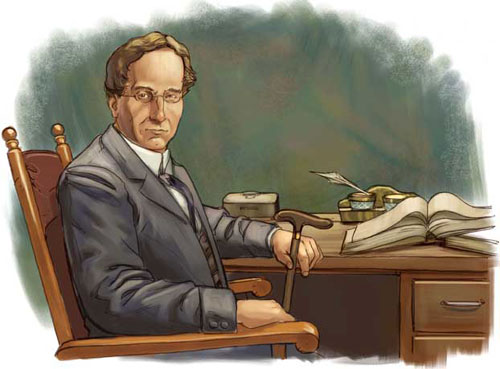 
|
Day labourer |
|
| Portrait of your character
Draw a comic strip to present your historical character. Use the texts, images, and links below to inspire you. You can create your comic strip using drawing tools in your word processing or drawing software.
|
|
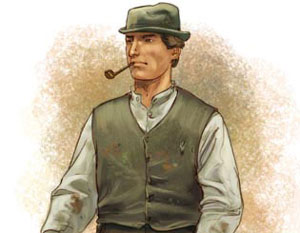 |
Hello,
My name is John O’Connor. I’m an Irish immigrant and I work as a day labourer. In 1818, at the age of 16, I immigrated to Lower Canada with my parents and siblings. We left Ireland to escape misery and poverty. My parents had to spend their last savings to get us on the boat. They hoped to be able to find work in North America to feed their family. Conditions on the boat were terrible. Several people were sick and we didn’t have much to eat. Like many other people, my parents didn’t make it. They died on the boat before we arrived here. |
| I arrived in Montréal a month ago, in July 1821. I was hired to work on the Lachine Canal, along with a great many others. It’s a huge project. Many of the other labourers are Irish like me. I can speak English with them and reminisce about home. We work very hard for a pittance, and our living conditions are terrible. We live crammed into shacks where epidemics are frequent. Wealthy people, on the other hand, have built their homes near Mount Royal.
The Lachine Canal is supposed to officially open in 1825. Once it does, boats will be able to sail from the Atlantic Ocean all the way to the Great Lakes, a dream come true for wealthy British merchants. Montréal will become a major port and the main gateway to the interior. To find out more about the society of Lower Canada in the 1820s, visit our 1820s section. |
|
| Irish immigrants boarding for the American continent |
 |
Work to widen the canal at St. Gabriel Lock (1877)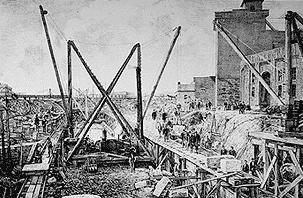
|
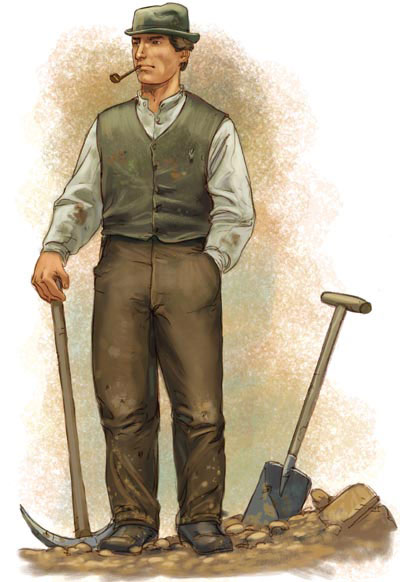 |
Farmer |
|
| Portrait of your character
Draw a comic strip to present your historical character. Use the texts, images, and links below to inspire you. You can create your comic strip using drawing tools in your word processing or drawing software.
|
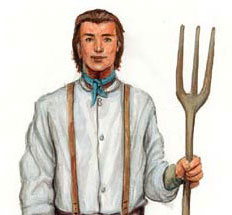 |
Hello,
My name is Baptiste. I live in Saint-Eustache in a small log cabin. I’m a farmer. Although I’m only 21 years old, I already have some farming experience as I worked alongside my father for a few years. Farming is very hard work. Sometimes I think my father worked himself to death. He was only 41 years old when he died. I inherited his land and now it’s my turn to feed my family. I’ve become the man of the house. |
| For the last few years, our harvests haven’t been very good. My father also complained about this. The summers are getting drier and the winters are harsher. Five years ago, in 1816, our harvests were terrible. We had to borrow money just to get through the winter.
We only cultivate part of our land. The rest is left fallow, which means it’s left unplowed and unseeded during a growing season. This rest period means the land will yield more the following year. Farming is a hard life, but I will spare no effort to continue because I’m attached to the land my father left me. I know there’s an enormous amount of work to do and that the harvests yield barely enough to feed my family. Sometimes I must leave my family for a few days to buy tools or sell parts of our harvest. In fact, I’m going to Montréal this summer to make a few purchases. To find out more about the society of Lower Canada in the 1820s, visit our 1820s section. |
|
| Baptiste’s family |
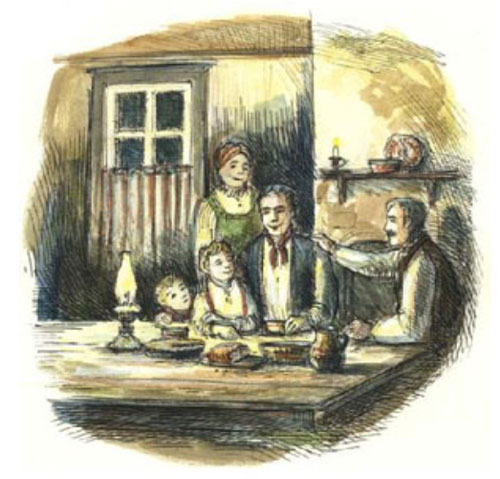 |
| Land clearing |
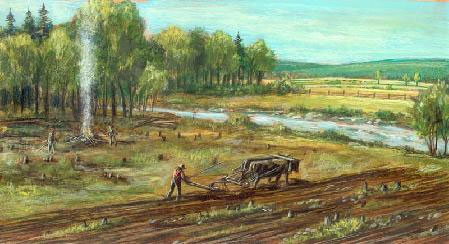 |
| Harvesting |
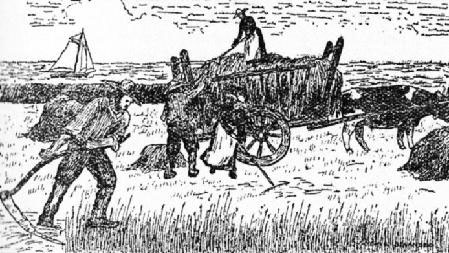 |
| Wood cutting in the winter |
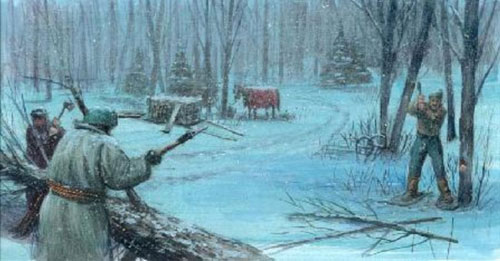 |
| Maison à St-Eustache |
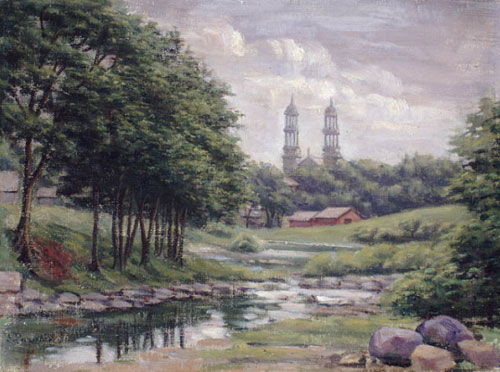 |
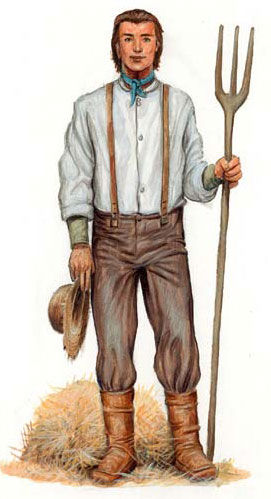 |
Nun |
|
| Portrait of your character
Draw a comic strip to present your historical character. Use the texts, images, and links below to inspire you. You can create your comic strip using drawing tools in your word processing or drawing software. Working document to help you create your comic strip: Download
|
Hello,
My name is Sophie. I was born in Trois-Rivières in 1786, the same year as Louis-Joseph Papineau, an important politician in my day. From a very young age, I’ve always wanted to help the poor and the sick. This led me to join the Order of the Sisters of Charity in Montréal, who are better known as the Grey Nuns.
I could have joined the Ursulines in Trois-Rivières, but they focus primarily on education and I really wanted to work with the most downtrodden. Mother Marguerite d’Y ouville really inspired me. She was an amazing woman who gave her life to helping the poor and the sick.
Chapelet

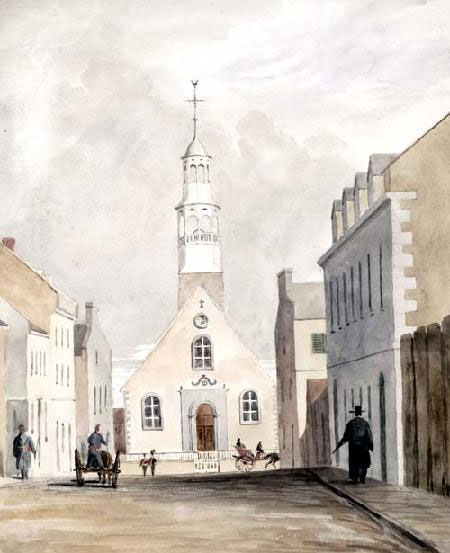
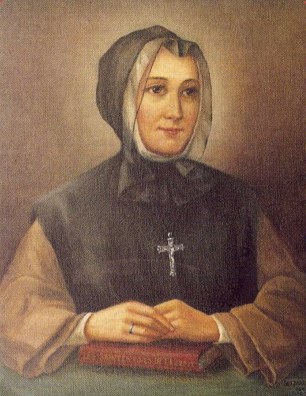
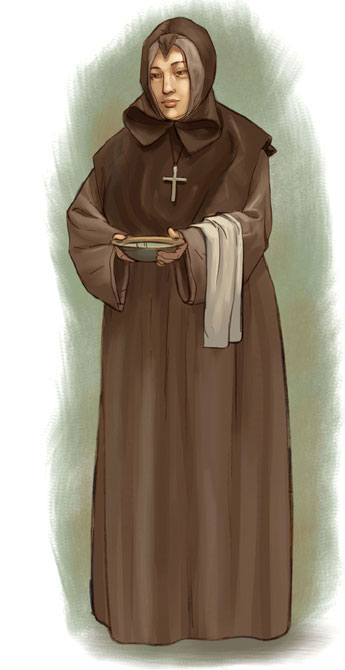
Seamstress |
|
| Portrait of your character
Draw a comic strip to present your historical character. Use the texts, images and links below to inspire you. You can create your comic strip using drawing tools in your word processing or drawing software.
|
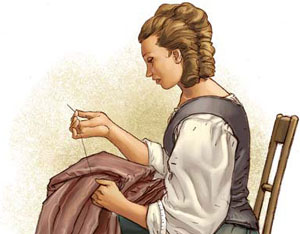 |
Hello,
My name is Marie. I’m 16 years old. I work as a seamstress for the wealthy family of Jacob De Witt. My job is to take care of the family’s clothing needs. Mr. De Witt is a very important man. He owns a sawmill and several steamships. He was a charter member of the Bank of Canada and also founded his own bank, Viger, De Witt et Cie, otherwise known as La Banque du Peuple (the “people’s bank”). He is a businessman of his time. |
| My days are long because I have a lot to do. Since the De Witts speak English, I also had to learn how to communicate in that language.I don’t live with my parents because they passed away a few years ago. I start my days at 7 a.m. and work until 7 p.m. I don’t have time for much else.
After supper, I go to church to say my prayers and then go straight to bed. I can’t stay up late because my days start so early. Still, I’m happy with my lot: I do God’s will and I will be rewarded in the next life. |
|
Lumberjack |
|
| Portrait of your character
Draw a comic strip to present your historical character. Use the texts, images and links below to inspire you. You can create your comic strip using drawing tools in your word processing or drawing software.
|
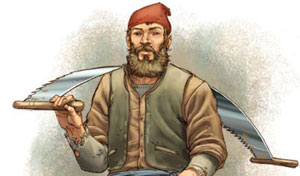 |
Hello,
My name is Pierre and I’m the son of a farmer. Let me tell you a bit about my life. Once the harvesting is done, I pack my things and head to the logging camp. Like many sons of farmers and even some farmers themselves, I go to the woods at this time of year to work as a lumberjack. |
| Life in a logging camp is hard. We work long hours and the work is gruelling. You must have a strong character and be in good shape to do this work. Everything is done manually, although we do use horses for the heaviest work. We work hard, but our foreman is never happy. He always pushes us to do more!We live all crammed together in a shack with only the barest of necessities. A cook makes our food, but we often eat the same thing. Baked beans are a staple of our diet.I miss my family. Many of the loggers suffer from the isolation and are bored. Many are married and have children. They won’t see their families for weeks. In the spring, the ice on the rivers will thaw. The logs we’ve cut will be sent down the rivers to the various sawmills. At that time, many lumberjacks will become raftsmen.To be a raftsman you have to be quick on your feet because you have to keep your balance on the floating logs. While they are working, the men live on timber rafts that follow the logs down the river. It’s extremely dangerous work.We keep up each other’s morale by thinking about our pay. Unfortunately, we aren’t paid much, just enough to get through the rest of the year.To find out more about the society of Lower Canada in the 1820s,visit our 1820s section. |
|
| The timber raft (ca. 1868) |
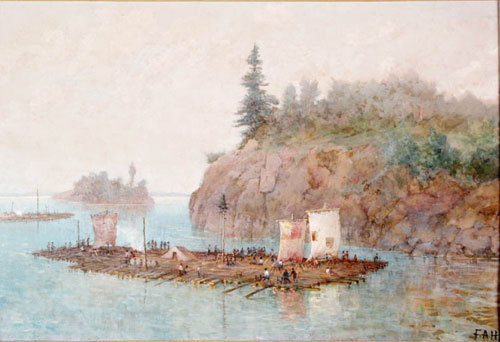 |
| Deux raftmans en équilibre! |
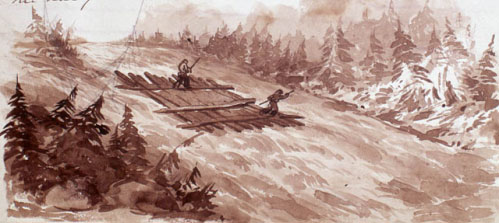 |
 Cabin in the woods (ca. 1840) Cabin in the woods (ca. 1840)Archives du Canada C-000921 |
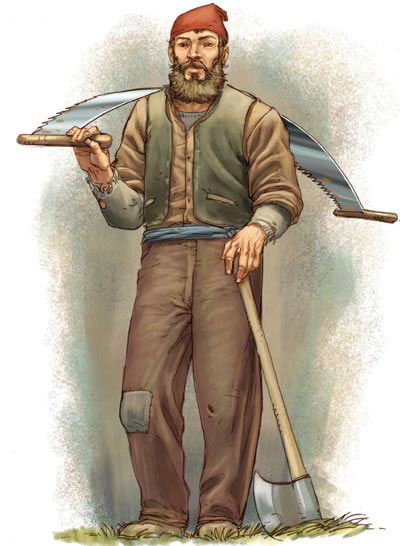 |
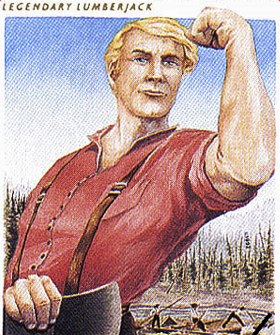 Source: Canada Post Corporation (cropped image) / Library and Archives Canada / ITEMLEV34086 |


